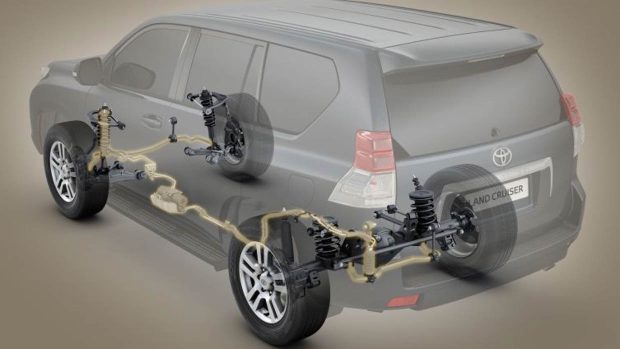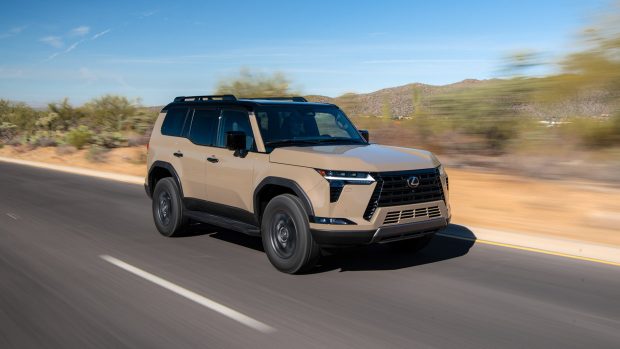-
Car Reviews
- All reviews
- Midsize SUVs
- Small cars
- Utes
- Small SUVs
- Large SUVs
- Large cars
- Sports SUVs
- Sports cars
- Vans
Latest reviews
- Car News
-
Car Comparisons
Latest comparisons
- Chasing Deals
Fans of KDSS may be disappointed to see the technology disappear from the Prado lineup – but its replacement is claimed to be even better
The soon to arrive ‘J250’ Toyota Land Cruiser Prado is all but certain to drop the brand’s renowned and Australian-developed Kinetic Dynamic Suspension System (KDSS).
But Toyota – crucially – claims that its approach to stabilisation and articulation in the new Prado is superior to the old ‘J150’ model even when fitted with KDSS.
The new-generation Prado, which lands in Australia later in 2024, will be available in ‘standard’ form, or with new ‘Stabiliser with Disconnection Mechanism’ (SDM) technology on the Altitude grade.
While full specifications for the new Prado are yet to be released for the Australian market, the unveiling of the related sixth-generation 4Runner model in the United States last week all but confirmed a suspected pattern.
Both the previous generation 4Runner and Prado were fitted with hydraulic-driven KDSS, but both new-generation replacements are instead fitted with SDM on the off-road-focussed grades.
Importantly, Toyota claims that even the basic new-gen Prado is superior in terms of articulation than its predecessor not only in its most basic form, but also when comparing newer models with SDM fitted against the old gen with KDSS.
The incoming, rugged Prado Altitude grade fitted with SDM is said to have superior suspension articulation to the new standard Prado variants due to a driver-operated disconnect switch for the front axle stabiliser bar.
Essentially, both systems in new Prado grades offer additional capability than a traditional setup by providing the 4WD with improved road-holding on sealed surfaces and more articulation off-road.
That said, Toyota’s KDSS system – and its modern, electronically-controlled e-KDSS replacement – remains a famed feature of top-end Land Cruisers.
E-KDSS remains the top-tier of Toyota’s available articulation systems. Chasing Cars understands that E-KDSS sits above and beyond SDM on articulation characteristics.
But Toyota has gradually made E-KDSS a feature exclusive to its most expensive four-wheel-drive models. It’s standard on the Land Cruiser 300 Series GR Sport.
For Prado buyers, it’s all but confirmed that there is only one way to get KDSS on the new-generation 250-series platform – and that’s purchasing the Lexus GX550 Overtrail grade.
For now, the GX Overtrail is the only Prado-related variant in the Toyota/Lexus lineup to nab E-KDSS. The actual Prado range is understood to cap out with SDM, at least at launch.
Despite the move away from the renowned KDSS, the J250 Prado is said to offer 10 percent greater articulation than the outgoing J150 Prado.
Driver’s are said to see another 10 percent improvement with the SDM system on the new model, over the previous Prado when KDSS is engaged.
SDM, which is effectively a straight-forward sway bar disconnect system, is however only fitted to the front axle (similar to the Jeep Wrangler Rubicon) whereas old KDSS worked in tandem across both the front and rear axle.
KDSS uses a hydraulic piston and cylinder mounted at both ends of the car (and connected together to form a complete circuit), allowing the sway bars to either perform as normal when locked or move more freely when the system is unlocked.
Notably however, more expensive off-roaders such as Prado’s luxury twin in the Lexus GX along with the larger Toyota Land Cruiser 300 Series and Lexus LX sibling have retained KDSS. Now known as E-KDSS in it’s latest form, it uses electric motors instead of hydraulic pistons as its basis, with the ability to manipulate the front and rear axles independently.
Historically KDSS has been offered in high-grade versions of Toyota’s flagship off-roaders, but has not been offered on the more affordable current generation Hilux ute or Fortuner for example.
Initially used in the first-generation Lexus GX back in 2004, KDSS was invented by research and development company Kinetic Pty Ltd based in Dunsborough, Western Australia.
Ultimately it remains to be seen if the switch to the newer technology will result in a better performing off-roader but its absence will no doubt be noticeable to a legion of Prado fans who hold great faith in the technology.
Latest news
About Chasing cars
Chasing Cars reviews are 100% independent.
Because we are powered by Budget Direct Insurance, we don’t receive advertising or sales revenue from car manufacturers.
We’re truly independent – giving you Australia’s best car reviews.





